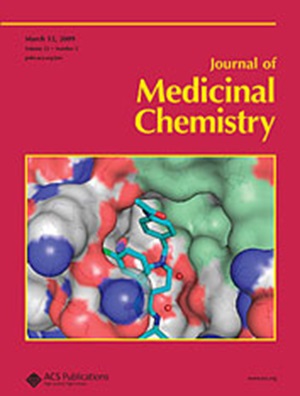Exploring Linear mono-, bis- and tris-Acetylene Containing Agonists of the Human Olfactory Receptor OR1A1
IF 6.8
1区 医学
Q1 CHEMISTRY, MEDICINAL
引用次数: 0
Abstract
Structure–activity relationship studies on olfactory receptors such as OR1A1 enhance an understanding of the molecular mechanism of olfactory perception. Such receptors are considered to be important in regulating physiological roles beyond olfactory perception. Here a series of linearized ketones, alcohols, and a cyclic ether, extended between the oxygen functionality and a terminal tert-butyl group with either mono-, bis-, or tris-acetylene spacers, was prepared to explore the response of human olfactory receptor OR1A1. The best agonists were bis-acetylene rods combined with an aryl spacer, including the bis-acetylene ketones 13 and 14, as well as the primary aryl-bis-acetylene alcohol 20 and the corresponding secondary alcohol 21. In the latter case, there was a clear stimulatory preference for the (R)-21 enantiomer. The experimental data were supported by molecular docking of the various ligands on the OR1A1 homology model. Further molecular dynamics simulations revealed atomic details in the OR1A1 binding pocket.

探索人类嗅觉受体OR1A1的线性单乙炔、双乙炔和三乙炔激动剂
对OR1A1等嗅觉受体构效关系的研究有助于进一步了解嗅觉感知的分子机制。这些受体被认为在调节嗅觉感知以外的生理作用方面很重要。本文制备了一系列线性化的酮、醇和环醚,在氧官能团和末端叔丁基之间用单乙炔、双乙炔或三乙炔间隔剂延伸,以探索人类嗅觉受体OR1A1的反应。最好的激动剂是结合芳基间隔剂的双乙炔棒,包括双乙炔酮13和14,以及伯芳基双乙炔醇20和相应的仲醇21。在后一种情况下,对(R)-21对映体有明显的刺激偏好。各种配体在OR1A1同源性模型上的分子对接支持了实验数据。进一步的分子动力学模拟揭示了OR1A1结合口袋中的原子细节。
本文章由计算机程序翻译,如有差异,请以英文原文为准。
求助全文
约1分钟内获得全文
求助全文
来源期刊

Journal of Medicinal Chemistry
医学-医药化学
CiteScore
4.00
自引率
11.00%
发文量
804
审稿时长
1.9 months
期刊介绍:
The Journal of Medicinal Chemistry is a prestigious biweekly peer-reviewed publication that focuses on the multifaceted field of medicinal chemistry. Since its inception in 1959 as the Journal of Medicinal and Pharmaceutical Chemistry, it has evolved to become a cornerstone in the dissemination of research findings related to the design, synthesis, and development of therapeutic agents.
The Journal of Medicinal Chemistry is recognized for its significant impact in the scientific community, as evidenced by its 2022 impact factor of 7.3. This metric reflects the journal's influence and the importance of its content in shaping the future of drug discovery and development. The journal serves as a vital resource for chemists, pharmacologists, and other researchers interested in the molecular mechanisms of drug action and the optimization of therapeutic compounds.
 求助内容:
求助内容: 应助结果提醒方式:
应助结果提醒方式:


